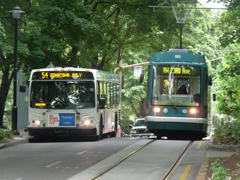 A move by a House Republican amidst surface transportation funding bill negotiations shows yet again why most Americans are shaking their heads in disgust and preparing to clean house this fall by electing members of Congress who care about the middle class.
A move by a House Republican amidst surface transportation funding bill negotiations shows yet again why most Americans are shaking their heads in disgust and preparing to clean house this fall by electing members of Congress who care about the middle class.
As conferees haggle over the much-needed surface transportation funding bill, Rep. Paul Broun (R-GA) is preparing a motion to instruct them to cut at least $17 billion from the Senate’s recommendation on how much to spend on surface transportation in FY2013. The original proposal included FY2012, which would have ended mass transit funding immediately and highway funding shortly thereafter. Both would cost hundreds of thousands of jobs at a time when the jobless rate is still too high.
How is this fiscal responsibility?
Those who support the Broun motion must live on a flat earth. They would be disregarding all we know about how infrastructure spending moves our economy, creates jobs and boosts our competitiveness with the rest of the world. Check the math – if you spend $1 billion on transportation you keep 25,000-30,000 people working. This proposal is just one more misguided attempt to curb spending by a junior member of Congress without any serious recognition of the consequences of this obvious slash-and-burn approach to policy-making.
If Broun had been around in the 1950s we’d probably still be talking about the vision of one day having an interstate highway system.
This proposed spending cut looks like the ugly stepchild of the House version of surface transportation reauthorization. Remember the attempt by House Republicans on the Ways and Means Committee to eliminate the Mass Transit Account? You know, the Mass Transit Account signed into law in 1983 by that liberal Ronald Reagan? Fortunately, that proposal never made it to the House floor.
The Broun funding cut proposal is advocated by the Heritage Action group. What does Heritage have against keeping our roads and bridges safe? Why do they want to end our public transportation program? Perhaps they should leave serious transportation issues to the transportation professionals before more working Americans change their Facebook status to “unemployed.”
When we talk about billions of dollars in spending, it can be difficult to put that into perspective. So let’s break it down into some real world examples. If studies show that most of our seniors live in rural areas and many of those are disabled, then our smaller towns and cities desperately need public transportation to get those folks to the grocery store, to medical care and to simply give them independence. Meanwhile in our major metropolitan areas, multiple modes of transportation are essential to reducing gridlock and stress levels while boosting productivity and the economy. Who can argue against the benefits of parents spending one extra hour in the evening with their kids instead of waiting on train platforms when commuter services are cut, or at the bus stop or inching toward home in traffic?
The trickle-down effect from spending on transportation is an absolute, real world example of how we must spend money to make money, and how we must invest in our future. An investment in transportation is an investment in our people. Let’s make wise choices. The Broun motion isn’t one of them.